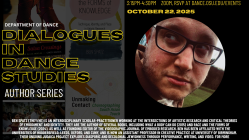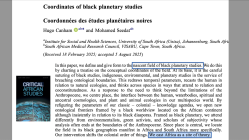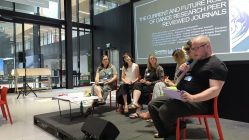Duration: 04:32
Project: Judaica
Song: Shishelai
Practitioner: Nazlıhan Eda Erçin, Agnieszka Mendel
Director: Nazlıhan Eda Erçin
Videography: Ben Spatz
Date: 2 June 2017
Venue: Centre for Psychophysical Performance Research
Source File: J060
COMMENTARY
Agnieszka
Very special transmission of a song. I have never experienced anything like this before.
I can’t see the face nor mouth of my teacher. I only can… hear her voice… sense the travel of her breath… and resonance sensations… through the entire surface of my back. I also can feel warmth, safety and that the song is being transmitted to me with a great care. My perception for capturing the song raised profoundly at this moment and Eda was leading me very ably, step by step, from most simple touching of sounds through sketches of melody to entire lines with lyrics eventually. She nursed each single sound, made sure that I understand and approximately follow the specific projection of voice.
Certainly, there was much more given than melody and rhythm. This transmission was very intimate. Like, I imagine, between mother and daughter, between two sisters or close girlfriends. There was certainly a deeper content beyond the surface values of the song.
I also appreciate the fact that Eda gave the song peaceful space, in a sitting position, focused strictly on the body of the song. Usually, I guess, Eda wouldn’t stay too long in a sitting position.
She would stand up and start stepping, bouncing, waving, walking. Such approach to song practise is captured in the songwork videos: impulses for vocal action 1, 2 and 3.
This eventually happened too, in the next phases of this session, but the ‘proper singing’ was granted a generous amount of time. Moreover, it took an unpredicted shape.
Eda
This is the period in the songwork when we decided to teach each other the songs that we’re individually working with. During our last focused trio conversation prior to this session, Agnieszka questioned the role of learning a song in the songwork, and underlined how crucial it is for her to learn proper singing as a practitioner/researcher.
- What does ‘proper’ mean in terms of proper singing?
- How can I teach a song as a practitioner who has not been classically trained as a singer?
- If the song is in Turkish, does it automatically make me the expert of it as the only native Turkish speaker in the laboratory?
The idea of proper singing made me ask to myself whether I had a pedagogy of teaching a song or not, and how would that pedagogy engage with the task of proper singing (especially when the ultimate purpose of learning is not to perform what’s learned for an audience).
I am a difficult learner in learning structured forms. Most of my experience with dance choreography, playing percussion or tae kwon do where I was asked to watch and copy exactly what I saw have been discouragingly challenging, at least in the beginning. To learn things, I need an individualised opening or sample to meet the material and potentially enjoy it. Only with that joy, I find an urge to follow or surrender the rest. If it is a form of accuracy or truthfulness that we are talking about to refer to what proper is, I suggest my pedagogy seeks simple, accessible, inclusive, and embodied ways into the song. Sitting back to back with Agnieszka, I offer her what I call the smallest unit of the song, one note in one syllabus in one sound. We repeat the ‘NA’ sound, slowly weave it into the melody without lyrics, and we find, loose, and re-find the right notes and keys along the way.
Ben
I am very interested in the idea of ‘proper’ singing and also its opposite, which I don’t think is ‘improper’ singing but something more like ‘free’ or ‘experimental’ singing. I think Agnieszka’s point about learning the songs properly is important, but I also think it requires further unpacking.
In order to learn a song properly you have to make some assumption about what the song is. In our case, I have proposed that we work from a set of audio recordings. For me, those recordings are what the songs are and any sense of propriety must be in relation to them. But the first song Eda chose to work with is one that she already knew! For her, ‘Shishelai’ can never be just that particular recording, especially since she hears the accent of the singer and determines that they are not a native speaker of Turkish. Yet I still want to claim that authenticity is not located elsewhere, in a Platonic ideal of a song, but in particular acts and moments of singing. For myself, what is authentic is not just the recording itself or my own act of singing but the relationship between these. When I started working on the ‘Yearning Tune’ in the studio, I didn’t know the song very well. I immediately invented a melodic variation which is not in the song but which generated a resonant physical action and which for me fits the action of the song — what I am trying to do with it, which is also how I understand what it is trying to do through the recording from which I learned it.
Perhaps the point here is not about ‘proper’ singing but about care in relation to a song. In that case there can be many different kinds of care. Finding sheet music in order to perfectly memorize a melody is only one kind of care and I would suggest that sometimes this kind of care can distract us from other kinds. For example, one could memorize a transcribed melody and in this way fail to engage with an underlying mode or improvisational structure. I would go even further, beyond a musicological understanding of song: Caring about melody, or even about scale and mode, can distract from caring about action, relation, identity, and politics. When I allow myself to work freely or experimentally with the ‘Yearning Tune’, that is based on a kind of claim I want to make with regard to the Hasidic impulse. I identify with this impulse and want to claim an authentic relation to it that is linked to the origins of Hasidism but not necessarily to currently existing Hasidic communities or dynasties. This claim is grounded in my own deep sense of care for my Eastern European Jewish lineage as well as for the place of mysticism and spirituality in an apparently secular laboratory context. If I did not care so much about those things then perhaps I would care more about memorizing the exact melody that is recorded on the album Hassidic Tunes of Dancing & Rejoicing, from which I learned that song.
In this video, I wanted to capture the sense of deep care that was emerging from the partnership of Eda and Agnieszka. With their eyes closed and backs touching, the sense of care is palpable: Eda’s care for the song as well as her care in teaching it to Agnieszka and Agnieszka’s care in learning and soaking in what Eda is offering.







[…] is an ongoing research within songwork which I continue proposing in our subsequent work. (See ‘back to back transmission’ and ‘entering a song through physical […]
[…] 2 June 2017 threading impulses into the song back to back transmission […]